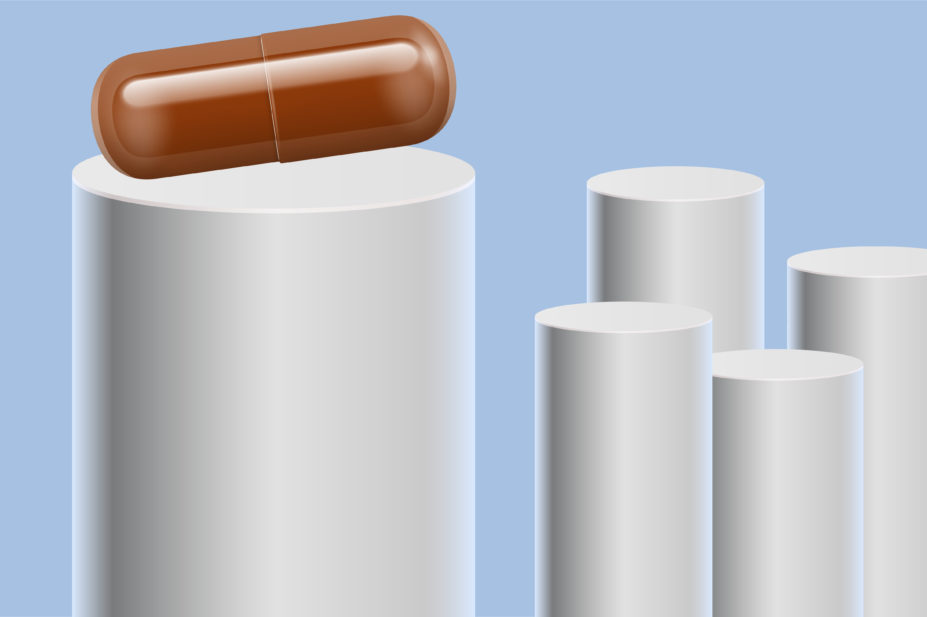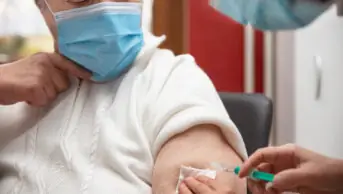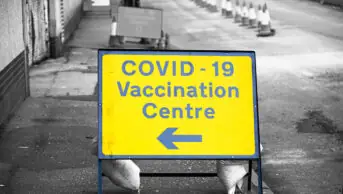
McLean
The approval of direct-acting antiviral drugs (DAA), which target virus-specific aspects of replication, has been hailed by the UK government (and other governments able to afford them) as a foundation of “living with COVID”[1]. They certainly help, but this is part of a flawed premise that SARS-CoV-2 prevalence, (re)infection and long COVID are extraneous in well-vaccinated populations where vulnerable people can theoretically access them to help prevent severe disease.
Moulding remdesivir (Veklury; Gilead), molnupiravir (Lagevrio; Merck) and Paxlovid (nirmatrelvir + ritonavir; Pfizer) — much like vaccines — into a ‘silver bullet’ or a quick-fix solution to the pandemic is problematic. Announcing the new UK Antivirals Taskforce in April 2021, UK prime minister Boris Johnson ambitiously speculated that, by autumn of that year, we would be able to take as-yet unidentified antivirals home from the pharmacy[2]. Of course, one year later this has not happened, but the taskforce has amassed a formidable antivirals stockpile and links the treatment of non-hospitalised patients (see Box) to an impressive trials network[3].
A growing minority of patients taking Paxlovid are experiencing relapsed infections ten or so days after beginning an ostensibly effective antiviral treatment
However, concerns have arisen over antivirals’ accessibility and availability to some patient groups considered clinically vulnerable, who have been previously required to shield[4]. This is compounded by the dramatic scaling back in free COVID-19 testing in England from April 2022.
The current ‘living with COVID-19’ pandemic policy in the UK remains rife with platitudes and an over-reliance on these new medicines, ultimately limiting their future usefulness[1]. Cracks in the veneer have predictably started to appear as antiviral use expands. A growing minority of patients taking Paxlovid are experiencing relapsed infections, with varying disease severity, ten or so days after beginning an ostensibly effective antiviral treatment[5]. This is not surprising, but patients can certainly be forgiven for this not being on their list of expectations given the political hubris surrounding their approval[6].
Why, then, is this happening and what can, or should, we do about it?
Suppressing infection
An infection is a race between the virus and our immune response, one where the virus gets a considerable head start. In the case of SARS-CoV-2, it wins this race by copying itself and spreading to new hosts. If we are vaccinated, then we are poised on the starting blocks and can run faster to catch up and win the race. However, our ability to run varies depending on our genetics, and sometimes there is no clear winner. Instead, the race can become a long, complicated and damaging steeplechase that results in severe COVID-19. Giving DAAs puts hurdles in the path of the virus, unties its shoelaces and weighs it down, ultimately stopping it disappearing into the distance, allowing slower runners to catch up.
So, because DAAs suppress rather than eliminate viruses, your immune system is still required to purge infected cells and trap virus particles using neutralising antibodies. Vaccination is always preferable to infection as it usually gives a more reliable, broad and potent response than that generated by infection; a better sprint start[7]. Plus, while scientists have identified many factors that make people slower runners, including obesity and diabetes, by no means do we understand them all. Put simply, we all take a chance every time we are (re)infected. Unchecked prevalence increases the incidence of otherwise rare events, such as children and young people becoming seriously unwell, plus it is driving a parallel epidemic of long COVID in the UK and worldwide[8].
Immunological illness
We should not underestimate the difficulty of drugging a fast-moving respiratory virus such as SARS-CoV-2 and doing so in a timely manner, because it is one area where comparison with seasonal influenza is valid. Tamiflu (oseltamivir; Genentech) and Relenza (zanamivir; GSK) were famously criticised by Cochrane for reducing the course of illness by a day or so, and a lack of evidence that they prevented pneumonia or hospital admissions[9]. However, when you consider that influenza is also well ahead in the race and has generally already been passed on to others by the time an individual develops symptoms and seeks treatment, the challenge becomes ever clearer.
Over the disease course, COVID-19 transitions from an acute viral to a predominantly immunological illness, which can be treated using immunomodulatory drugs, such as dexamethasone and IL6 antagonists[10]. This is also why — despite the profound clinical need — results from early remdesivir trials in hospitalised patients with severe COVID-19 were ambiguous[11]. While a small effect was evident on the progression of less serious cases, no effect was apparent following ventilation — treatment was too late.
One plausible but unproven explanation for viral relapse is an immunological ‘catch 22’, where direct-acting antivirals suppress the virus so quickly that their immune response does not have a chance to run its race
This is a common predicament for antiviral therapy, whereby those in most clinical need can also be those least likely to respond. As a result, outpatient trials of antivirals were geared towards keeping high-risk patients — defined as those with at least one known COVID-19 risk factor for remdesivir and molnupiravir, and unvaccinated patients in Paxlovid trials — out of hospital via early intervention, rather than curative suppression of virus replication[12–14]. This reliance on early intervention means that reduced testing capacity and infrastructure in the UK presents a potentially life-threatening obstacle to obtaining rapid DAA treatment.
One plausible but unproven explanation for viral relapse post-DAA is an immunological ‘catch 22’, where DAAs suppress the virus so quickly in some patients that their immune response does not have a chance to run its race. Ultimately, your immune system needs to recognise that the virus is there before it can mobilise — we do not start running until the starting pistol fires. In this setting, where infected cells are not dispatched, the virus can effectively lay low and return once the drug is removed.
A recent preprint, released in April 2022, describes this phenomenon in terms of viral re-emergence, but more data are necessary to determine whether such an immunological scenario applies to any or all cases of viral relapse[15]. Determining this may be confounded by the natural decline of viral RNA in the upper respiratory tract that follows the peak of infection in most patients. DAAs, including Paxlovid, enhance this decline, more obviously in unvaccinated patients and in those in whom the viral peak was greater than 107 copies/mL[14].
Potential for resistance
Other possible explanations for relapse include the potency/duration of treatment simply not being good/long enough in some vulnerable patients, or that SARS-CoV-2 is able to develop resistance over the relatively short course of therapy.
As with all medicines, each of these drugs has advantages and disadvantages. Paxlovid and remdesivir provide greater protection versus hospitalisation (both ~87% risk reduction) compared with molnupiravir (~30%)[12–14]. On the other hand, remdesivir is given intravenously in a healthcare setting, while the others are taken orally. Paxlovid combines the active protease inhibitor nirmatrelvir with another drug, ritonavir, which impairs the ability of the liver to process foreign substances efficiently (via inhibition of cytochrome CYP3A4). While this increases nirmatrelvir potency, it can also cause problematic interactions with other medicines, including immunosuppressants, arrhythmia treatments and anticoagulants[16]. Finally, molnupiravir has teratogenic potential, reminiscent of the influenza drug favipiravir, meaning those aged under 18 years and pregnant women are unable to access the drug[17].
Extending outpatient treatment beyond five days was not included in the three phase III trials for remdesivir, molnupiravir and Paxlovid, reported in the New England Journal of Medicine, so extended dosing would constitute off-label use as all safety, toxicity and pharmacokinetic data are based upon five-day regimens[12–14]. The US Food and Drug Administration also refused to authorise a proposed second round of Paxlovid in relapsing COVID-19 patients owing to a lack of supportive evidence[18].
Caution is absolutely required as antiviral use increases
Extended dosing has been undertaken for hospitalised patients on remdesivir, and prolonged treatment in immunocompromised patients is potentially the main concern for the development of drug resistance, more so than increased short-term community use[11,19,20]. However, should circumstances lead to over-reliance and escalation of antiviral use in the face of unmitigated prevalence, this too presents a risk.
Reassuringly — for now at least — a UK Health Security Agency report, published in January 2022, found that neither Paxlovid nor molnupiravir use is associated with any report of post-treatment sequence changes in the virus potentially linked to resistance in available UK sequences[21]. Remdesivir, for which many more sequences are available, has led to rare changes in the NSP12 RNA dependent RNA polymerase (the virus-encoded enzyme responsible for making new copies of the viral genome, acting alongside other non-structural proteins), but so far exclusively in a small number of non-Omicron, non-Delta, hospitalised patient sequences. However, caution is absolutely required as antiviral use increases, especially given that two recent pre-prints from highly regarded laboratories have identified that nirmatrelvir resistance readily arises in cell culture via mutations in mPro, the main protease that Paxlovid inhibits, and that these do not appear to reduce the ability of the virus to replicate, albeit in cell culture[22,23]. It will be critical to assess whether such changes occur following Paxlovid therapy and whether resultant viruses retain the ability to spread in vivo.
New drug combinations
The message here is that advances in DAAs for SARS-CoV2 should be celebrated, but we must not overburden them as we are doing with vaccines; they are an important part of the solution but they are not silver bullets[24].
Antiviral treatment of chronic virus infections, such as HIV and hepatitis C (HCV), has taught us how to mitigate against drug resistance by use of combinations. This not only suppresses the chance of resistance arising — it is literally a numbers game — but can also lead to synergy where the overall antiviral effect is greater than the sum of its parts. Importantly, this appeared to be the case for nirmatrelvir and remdesivir based on data from one of the Paxlovid resistance preprint studies[22].
Thus, I would actively call upon the companies behind licensed agents to cooperate and mount appropriate SARS-CoV-2 trials looking at combinations with some urgency. Intelligent use of these drugs will ultimately extend their usefulness. Until this happens, use of these agents should be for those in genuine need (a list that requires some reformation in the UK) and this should be supplemented by addressing the fundamentally flawed notion that transmission can run unchecked without consequence[25].
When we turned in panic to the antivirals cupboard in 2020 it was effectively empty in terms of suitable SARS-CoV2 compounds with human safety and pharmacokinetic profiles. We were lucky to have repurposed and adapted remdesivir from HCV programmes, molnupiravir from Venezuelan equine encephalitis virus (VEEV), and the innovative chemistry that derived nirmatrelvir was based upon a previously developed SARS-CoV-1 targeted molecule[26].
We now need second and third-line treatments that can be used as combinations, which requires ongoing investment into both clinical trials and preclinical development. Worldwide government investment in antivirals, as seen recently for vaccines, would far better prepare us for the initial outbreak stage of the next pandemic. It would be encouraging to see the UK take a lead in this regard after the success of vaccine funding programmes.
The question now is whether such long-term planning will be prioritised, or whether living with COVID-19 means that we down tools and allow history to repeat itself.
Box: Vulnerable patient populations
Patient cohorts to be prioritised for treatment with neutralising monoclonal antibodies and oral antivirals:
- All patients with Down’s syndrome;
- Some patients with a solid cancer, such as active metastatic cancer, or active solid cancers at any stage;
- Some patients with a haematological disease and stem cell transplant recipients (e.g. all patients with sickle cell disease);
- Some patients with renal disease (e.g. renal transplant recipients);
- Some patients with liver disease (e.g. those on immunosuppressive therapy);
- Some patients with immune-mediated inflammatory disorders (those who have received treatment with rituximab or another B cell depleting therapy in the past 12 months);
- Some patients with primary immune deficiencies (e.g. severe combined immunodeficiency);
- Some patients with HIV/AIDS (e.g. those with high levels of immune suppression);
- All solid organ transplant recipients;
- Some patients with rare neurological conditions, such as multiple sclerosis.
Patient cohorts to be prioritised for a fourth COVID-19 vaccine (advised around six months after the first booster dose):
- Adults aged 75 years and over, residents in a care home for older adults;
- Individuals aged 12 years and over who are immunosuppressed (e.g. patients receiving cancer therapy).
Those who are eligible can get their vaccine by providing either a letter from a GP team or specialist inviting them for a vaccine, a hospital or GP letter about their medication or treatment, or a prescription or medication box with their name and date on it.
- 1COVID-19 Response: Living with COVID-19. GOV.UK. 2022.https://www.gov.uk/government/publications/covid-19-response-living-with-covid-19/covid-19-response-living-with-covid-19 (accessed 14 Jun 2022).
- 2Government launches COVID-19 Antivirals Taskforce to roll out innovative home treatments this autumn. GOV.UK. 2021.https://www.gov.uk/government/news/government-launches-covid-19-antivirals-taskforce-to-roll-out-innovative-home-treatments-this-autumn (accessed 14 Jun 2022).
- 3The COVID-19 Antivirals and Therapeutics Taskforce: Antivirals. GOV.UK. https://www.gov.uk/government/groups/the-covid-19-therapeutics-taskforce#antivirals (accessed 14 Jun 2022).
- 4Lovett S. Clinically vulnerable Covid patients denied access to life-saving antivirals. Independent. 2022.https://www.independent.co.uk/news/health/covid-antiviral-nhs-treatment-latest-b2047467.html (accessed 14 Jun 2022).
- 5Lee BY. Paxlovid Rebound: FDA Investigating Reports Of Covid-19 Relapses After Taking Pfizer Antiviral. Forbes. 2022.https://www.forbes.com/sites/brucelee/2022/05/19/paxlovid-rebound-some-suffering-covid-19-relapses-after-taking-pfizer-antiviral/?sh=34fa2420b8e4 (accessed 14 Jun 2022).
- 6Highest risk COVID-19 patients receive ‘brilliant’ new antivirals at home. NHS England. 2022.https://www.england.nhs.uk/2022/04/highest-risk-covid-19-patients-receive-brilliant-new-antivirals-at-home/ (accessed 14 Jun 2022).
- 7Suryawanshi RK, Chen IP, Ma T, et al. Limited cross-variant immunity from SARS-CoV-2 Omicron without vaccination. Nature. 2022. doi:10.1038/s41586-022-04865-0
- 8Prevalence of ongoing symptoms following coronavirus (COVID-19) infection in the UK: 6 May 2022. Office for National Statistics. 2022.https://www.ons.gov.uk/peoplepopulationandcommunity/healthandsocialcare/conditionsanddiseases/bulletins/prevalenceofongoingsymptomsfollowingcoronaviruscovid19infectionintheuk/6may2022 (accessed 14 Jun 2022).
- 9Tamiflu and Relenza: getting the full evidence picture. Cochrane. 2014.https://www.cochrane.org/news/tamiflu-and-relenza-getting-full-evidence-picture (accessed 14 Jun 2022).
- 10The COVID-19 Antivirals and Therapeutics Taskforce: UK clinical platform trials. GOV.UK. https://www.gov.uk/government/groups/the-covid-19-therapeutics-taskforce#uk-clinical-platform-trial-results (accessed 14 Jun 2022).
- 11Remdesivir and three other drugs for hospitalised patients with COVID-19: final results of the WHO Solidarity randomised trial and updated meta-analyses. The Lancet. 2022;399:1941–53. doi:10.1016/s0140-6736(22)00519-0
- 12Gottlieb RL, Vaca CE, Paredes R, et al. Early Remdesivir to Prevent Progression to Severe Covid-19 in Outpatients. N Engl J Med. 2022;386:305–15. doi:10.1056/nejmoa2116846
- 13Jayk Bernal A, Gomes da Silva MM, Musungaie DB, et al. Molnupiravir for Oral Treatment of Covid-19 in Nonhospitalized Patients. N Engl J Med. 2022;386:509–20. doi:10.1056/nejmoa2116044
- 14Hammond J, Leister-Tebbe H, Gardner A, et al. Oral Nirmatrelvir for High-Risk, Nonhospitalized Adults with Covid-19. N Engl J Med. 2022;386:1397–408. doi:10.1056/nejmoa2118542
- 15Gupta K, Strymish J, Stack G, et al. Rapid Relapse of Symptomatic SARS-CoV-2 Infection Following Early Suppression with Nirmatrelvir/Ritonavir. 2022. doi:10.21203/rs.3.rs-1588371/v1
- 16Ritonavir Interactions. National Institute for Health and Care Excellence. https://bnf.nice.org.uk/interactions/ritonavir/ (accessed 14 Jun 2022).
- 17Zhou S, Hill CS, Sarkar S, et al. β-<scp>d</scp>-N4-hydroxycytidine Inhibits SARS-CoV-2 Through Lethal Mutagenesis But Is Also Mutagenic To Mammalian Cells. The Journal of Infectious Diseases. 2021. doi:10.1093/infdis/jiab247
- 18Becker Z. FDA rebukes Pfizer CEO’s suggestion to take more Paxlovid if COVID-19 symptoms return. Fierce Pharma. 2022.https://www.fiercepharma.com/pharma/fda-rebukes-pfizers-suggestion-take-more-paxlovid-if-covid-19-symptoms-return (accessed 14 Jun 2022).
- 19Beigel JH, Tomashek KM, Dodd LE, et al. Remdesivir for the Treatment of Covid-19 — Final Report. N Engl J Med. 2020;383:1813–26. doi:10.1056/nejmoa2007764
- 20Kemp SA, Collier DA, et al. SARS-CoV-2 evolution during treatment of chronic infection. Nature. 2021;592:277–82. doi:10.1038/s41586-021-03291-y
- 21COVID-19 therapeutic agents: technical briefings. GOV.UK. 2022.https://www.gov.uk/government/publications/covid-19-therapeutic-agents-technical-briefings (accessed 14 Jun 2022).
- 22Zhou Y, Gammeltoft KA, Ryberg LA, et al. Nirmatrelvir Resistant SARS-CoV-2 Variants with High Fitness in Vitro. 2022. doi:10.1101/2022.06.06.494921
- 23Jochmans D, Liu C, Donckers K, et al. The substitutions L50F, E166A and L167F in SARS-CoV-2 3CLpro are selected by a protease inhibitor in vitro and confer resistance to nirmatrelvir. 2022. doi:10.1101/2022.06.07.495116
- 24Covid-19: An urgent call for global “vaccines-plus” action. BMJ. 2022;:o1. doi:10.1136/bmj.o1
- 25Kozlov M. Why scientists are racing to develop more COVID antivirals. Nature. 2022;601:496–496. doi:10.1038/d41586-022-00112-8
- 26Owen DR, Allerton CMN, Anderson AS, et al. An oral SARS-CoV-2 M pro inhibitor clinical candidate for the treatment of COVID-19. Science. 2021;374:1586–93. doi:10.1126/science.abl4784


